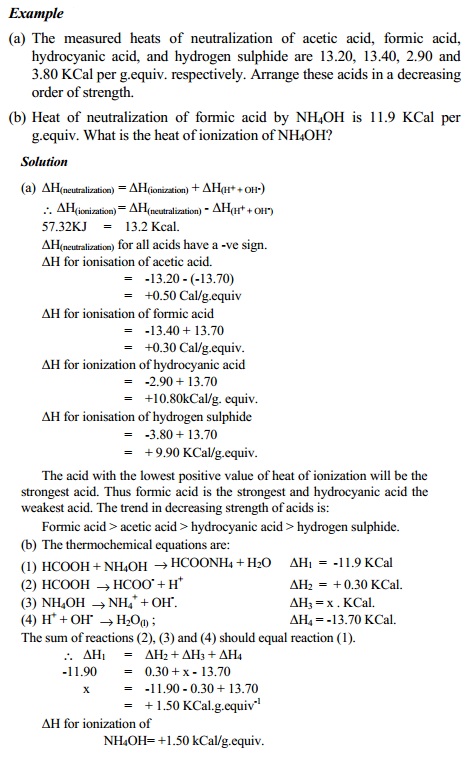Chapter: 11th 12th std standard Class Organic Inorganic Physical Chemistry Higher secondary school College Notes
Enthalpy of neutralisation
Enthalpy of neutralisation
The enthalpy change of
neutralisation is defined as the enthalpy change accompanied by the
complete neutralisation of one gram - equivalent amount of a strong acid by a
gram-equivalent amount of strong base under fully ionised state in dilute
conditions. It is found that the enthalpy of neutralisation of a strong acid
and a strong base is a constant value equal to -57.32 kJ. This value is independent
of the nature of the strong acid and strong base. Strong acids and strong bases
exist in the fully ionised form in aqueous solutions as below:
H3O+ + Cl- + Na+
+ OH- -- -- > Na+
+ Cl- + 2H2O (or)
H3O+(aq)
+ OH-(aq) -- -- >
2H2O(l) ∆neuHo = -57.32 KJ.
The H+ ions produced in water by the acid molecules exist as
H3O+. During the neutralisation reaction, water and salt
(existing as ions) are produced in solution. Thus, enthalpy change of
neutralisation is essentially due to enthalpy change per mole of water formed
from H3O+ and OH- ions. Therefore,
irrespective of the chemical nature, the enthalpy of neutralisation of strong
acid by strong base is a constant value. At infinite dilutions, complete
ionisation of acids and bases are ensured and also the inter ionic interactions
exist in the lowest extents.
In case of neutralisation of a weak acid like
acetic acid (CH3COOH) by a strong base (NaOH) or neutralisation of weak base
(NH4OH) by a strong acid, two steps are involved. The first step is
the ionisation of weak acid or weak base since these molecules are only
partially ionised. The second step being the neutralisation step of H3O+
and OH- ions. Since ionisation of weak acids and weak bases in water
are endothermic and some energy will be used up in dissociating weak acid and
weak base molecules.
Thus, acetic acid with NaOH and ammonium
hydroxide with HCl neutralisation reactions can be written as,
CH3COOHaq + H2O2 -- > CH3COO-aq + H3O+aq
Na+aq + H3O+aq
+ OH-aq -- > 2H2O(l) + Na+aq
and
NH4OH --
> NH4+ + OH-
H3O+ + Cl- + OH- -- > 2H2O + Cl-.
Enthalpy of neutralisation of a weak acid or a weak base is equal to
-57.32 kJ + enthalpy of ionisation of weak acid (or) base. Since enthalpy of
ionisation of weak acid or base is endothermic it is a positive value, hence
enthalpy of neutralisation of a weak acid or base will be lower than the
neutralisation of strong acid and strong base.

Related Topics